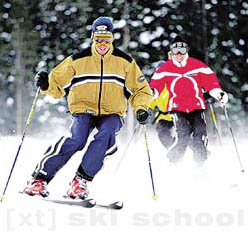|
On the Bunny Hill: Your First Time
Try to figure out how to get up the hill without the lift. You can't just walk up it, or you'll slide backwards. You have to side step or herringbone up. The sidestep is when you walk up one ski at a time always facing across the hill. The herringbone is when you walk straight up the hill but the skis make a V with the tails together. When sidestepping, you will find that the edges have to be set into the snow so you don't slide sideways. All these little tips are the first steps taken by ski instructors when getting you accustomed to standing and walking with skis. Next, the instructor will make you slide down a small hill for 20 feet or so barely moving. Taking things slowly in the beginning is the secret to learning.
The snowplow or wedge: how to stop
Next, you will learn how to make a wedge shape with the tips of the skis together and the tails apart. This is how you stop and control your speed. The wider the tails are spread the slower you will go. The tips, however, are always kept at about two inches apart. Sometimes they will touch, and sometimes they will go much wider. If this happens, don't worry, just try to get them back together. Control comes from being able to keep them near the optimal position.
You should try to keep your weight evenly distributed between the two skis, that is if you were to draw a line from the center of your body, it would hit exactly between the skis. This position will keep the skis going straight in the wedge position. It is this wedge that will allow you to control your speed and make your first turns. Get used to the feeling of sliding along in the wedge. The skis should feel like they are skidding on the inside edges. If you are in a proper wedge, the skis should be resting more on the inside edge than the outside edge. Don't try to overdo it. The body should be kept in a position like that of walking. Don't crouch or stoop over, even though you will want to. Just try to control the skis speed by making a bigger or smaller wedge. Remember, bigger means slower and smaller means faster.
I don't know how many times I've seen a person panic and let the skis naturally go parallel and thus lose their stopping power. The person forgets the instruction and starts heading for the parking lot unable to stop. Don't let the speed get away from you. Go slow in the beginning.
Turning in the wedge
The wedge turn is the pivot upon which you will enter into the world of downhill skiing. If you don't get it, try harder and longer. If you don't get the right technique in the wedge, you will be hindered all the way through skiing. Many ski instructors have to start from square one, even though their client may be able to parallel, simply because the fundamentals were never developed.
To make a turn in the wedge, just put a little more pressure on the outside ski while twisting both skis in the intended direction. You must be able to feel the skis slide sideways a little, or brush across the snow. While turning, try to keep the body upright, hands out in front like your holding a tray, and don't use your poles to assist in turning.
There are three things that have to happen to make a good wedge turn. First, the tips have to be together. Second, the outside ski has to have more weight on it than the inside ski. Third, you must steer both skis in the direction of the turn. The biggest problem encountered is when skiers put to much angle on the skis. The skis should only slightly be angled on the inside edges. If they are more, the ski will not slide sideways. It will want to track in a straight line. If you stand tall, the skis will be on the right angle. Until you can make turns both right and left in the wedge, don't even try to ski with your skis together or parallel. The wedge is the first step to skiing, and there is no way around it. You must learn how to do it well, before going any farther in skiing.
Alpine Skiing School section in english version of WWW.SKI.BG is based on
"A Guide To Becoming An Expert: From First Time To A Lifetime"
by John Mukavitz Copyright © 1998

|


